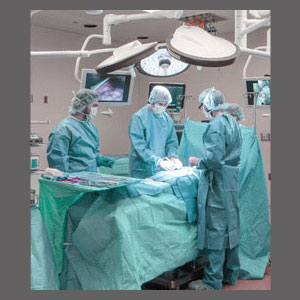
Spinal stenosis laser surgery is one of the more enlightened approaches to operative intervention, being that lasers are precise and minimally invasive surgical tools. Laser procedures have revolutionized the spinal surgery sector, allowing innovative techniques to be accomplished with the least amount of anatomical collateral damage possible. However, it must be noted that just because a procedure uses a laser does not mean that it is safe or effective. Even the least invasive of laser operations still maintain a great degree of risk and many result in severe complications, just like more traditional forms of spinal stenosis surgery.
The scope of this article will examine various types of laser spinal surgery used for stenosis, both of the central canal and the neuroforaminal spaces.
Central Spinal Stenosis Laser Surgery
Central spinal stenosis is often treated surgically. Being that cord compression can cause widespread and serious health effects, most patients who are indicated for surgical correction will elect to undergo a procedure which will remove the blockages from the spinal canal and hopefully restore neurological functionality. The type of procedure which will be utilized will depend greatly on the cause of the narrowed canal space:
For herniated disc spinal stenosis, a laser discectomy will usually be performed to reduce the bulge and remove it from impinging on the central canal.
For arthritic spinal stenosis, there are a few options, but most patients will receive a laser laminectomy and bone spur removal procedure.
For spondylolisthesis, scoliosis, lordosis and kyphosis conditions leading to a decreased central canal, laser spinal fusion will usually be the recommendation and may include reinforcing hardware.
Procedures are often case-specific and may be combined to treat multiple causes of spinal stenosis in one patient. Discectomy/fusion, laminectomy/foraminotomy and discectomy/laminectomy are some of the typical procedural combinations.
Laser Surgery on the Spinal Neuraforamen
Decreased neuroforaminal spaces may cause pinched nerves to occur, especially in the neck and lower back. The narrowed foramen are also commonly treated using any of the following surgical techniques.
Laser discectomy is utilized when a paracentral, foraminal or far lateral herniation blocks the neuroforaminal opening.
Laser laminectomy can be used to treat many arthritic cases of foraminal reduction.
Laser foraminotomy can trim the region around the facet joints, increasing space available for nerves to exit the foramen.
Once again, procedures are often combined to treat multiple contributors to a blocked foraminal space.
Spinal Stenosis Laser Surgery Information
Laser surgery may entail various uses of lightwave technology during the operation. In some cases, the laser may only be used minimally, like for performing incisions. In other instances, the laser may be utilized during the entire procedure.
Laser techniques minimize the risk of cross contamination. They also reduce blood loss and increase accuracy and precision of many surgical endeavors. Exclusive laser techniques may also reduce the risk for wound infection. While these are all very positive attributes, patients can still suffer from any of the risks common to all spinal operations and may still endure poor postoperative results. Fortunately, spinal stenosis is one of the conditions which responds best to back surgery when the diagnosis is correct and many patients can recover well after indicated surgical therapy.
Spinal Stenosis > Spinal Stenosis Surgery > Spinal Stenosis Laser Surgery





